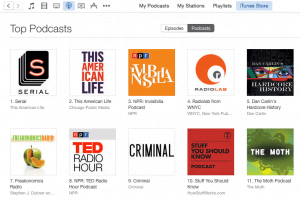
Let me just get this part out of the way:
At this moment I am compelled to write. I feel religious type zeal to write. I can’t NOT write. It has to get out of me. The voice in my head is too loud and I contribute it in part to the companionship of an old friend, let’s call him, John Davids (not his real name). I keep clinging to that old Hemingway quote that says, “Write drunk, edit sober” and am pushing forward.
And so it is. Now that’s out of the way…
If you are reading this you may know that host a podcast with a close friend of mine; Colby Saenz, called Talking 2 Myself. We’ve been live since Black Friday 2014 with a new episode every Friday for you: the listener. Well, for us the hosts as well. We made a commitment to put out a new episode every Friday and by golly… every Friday we will put out a new episode. We keep our commitments. Anyway, I digress.
The process of feeling like I have something to say and that somebody might give a shit enough to listen, well… that was the seed of Talking 2 Myself. Factor in some really great banter that has occurred over the years with my friend Colby and the seed took hold, became a living, breathing thing, and passed from a want to a need. We began creating our podcast.
What does that have to do with this blog post?
EVERYTHING.
If you listen to our Episode called “From Brazil to Black Friday” you will hear the story of our launch. What’s left out from that episode is the journey that I personally experienced honing my craft as a podcast host (still honing; let’s be honest). It first started by listening to Bad 4 Business by Jerry Ferrara. While an inspiration due to his role as Turtle on the HBO show Entourage, he was not an example to me for the “honing” part of the craft of hosting a podcast. He just had really interesting stories that personalized for me experiences I’d lived watching his acting career. I stumbled to other podcasts listening, dissecting, and taking notes.
The BS Report with Bill Simmons.
The Joe Rogan Experience.
All these were on my iPhone as subscribed podcasts.
They were all entertaining but not truly exceptional in each episode. This is my opinion of course, but nonetheless, while I was entertained to the point that I returned every week, I wasn’t blown away. It seemed like talk radio with fewer commercials.
In fairness, it is with this same level of scrutiny that I look at my own podcast. I am by far our worst critic. Colby and I are having a good time, but we aren’t curing cancer by any stretch. We still have our crutch words. We have holes in our arguments; we are new but recognized that we have something worth developing. And so we continue to develop it. I recall listening to our episodes over and over and over again, mulling over each word, each broken thought, each stutter, each “umm” etc. and I remember wishing there was a podcast that I could model that would give me a level as a standard to which I would hold myself.
Days later, it happened. I heard such a podcast.
I remember when I first heard his voice; that distinctive, nasally voice. And the interviewer was this smooth, familiar voice that brought me in. It was called “Here’s The Thing” and Alec Baldwin was interviewing the iconic Ira Glass; host of This American Life. I had seen TAL at the top of the iTunes Top 100, but I hadn’t listened yet. After the interview, I went to iTunes, subscribed, and starting listening to my first episode.
It was ep. 513: 129 Cars.
It was a story about a Long Island Jeep dealership and showed a behind the curtain account of all the personalities involved trying to get to the dealership goal of selling 129 cars in a month. They interviewed the individual salesman; the management, the staff. It was a fascinating theater. I recognized that the reason it was fascinating for me had nothing to do with the story itself. It was how they told the story. They had created a narrative that weaved its way through the whole hour of the episode. I laughed, I frowned, and I identified with characters that I had nothing in common with. It was the best storytelling I had heard in recent memory.
A few days ago I found better.
On a road trip from Boise, ID to Salt Lake City, UT I binge-listened to the first six episodes of a podcast called Serial that is done by the same folks who do This American Life. It is a 12-episode recount of the murder of a young Asian girl in 1999 and the ins and outs of a trial with no physical evidence and a HUGE shadow of a doubt that hangs over the whole deal. The host, Sarah Koenig, dissects this case with her own take with opinion, interviews, and conjecture that makes for some of the most compelling media I have ever heard. I just finished the last 6 episodes on a different road trip.
When I got home back to Salt Lake that first trip, it hit me.
It wasn’t the story. It was storytelling.
I had almost zero interest in a 15-year-old murder case. But, the way that she told the story and the layers she used to get me involved was perfectly deliberate. To give you an example, to build a foundation for her opinion Sarah Koenig spends a portion of the first episode interviewing a group of teenagers and asking them about what can they remember about an afternoon six weeks ago. The answers from this group of friends sway from total, complete recollection to not remembering anything. And each person contradicts each other’s story. She parlays this into the idea that a 21 minute stretch of time that one person can’t account for has resulted in a life sentence. Can you remember what you did for a 21-minute span six weeks ago? Me neither. It was fascinating. I was hooked and committed to telling a better story.
(There are layers to this commitment that I will get into in a later blog post).
Great storytelling is few and far between in 2014. In our immediate gratification culture, we usually don’t give the time necessary to a book, movie, podcast, etc. to let a truly great story develop; if it doesn’t hold our attention immediately we give up as a conditioned response.
Truly great storytelling can change this and coerce the listener to leave their phone in their pocket and stay engaged. Stay on the same channel, even when the listener is hearing a podcast.
Truly entertaining storytelling rises to the top in our media culture; we ultimately learn about it because others tell us about it. Like Serial; I have had many to which I’ve asked if they’ve heard about it say, “No, but I keep seeing it everywhere, what is it?” As a podcast host, this feels like an opportunity that borders on being a revival. Great storytelling is being revived; via the podcast.
This newest episode of Talking 2 Myself is our first attempt to superimpose a narrative into our podcast and tell a more compelling story. All our past episodes have somewhat of a narrative, but none like this. With just a small adjustment in format, we are encouraging the listener to understand via a simple suggestion the reason why we are interviewing who we are interviewing; or why we are talking about what we are talking about. For example, Joy Lane is an intriguing, rising star and stand-up comic. But the listener is introduced to our “why” with Colby’s intro before the interview begins. It’s so simple but incredibly effective.
I have no shame admitting that I “borrowed” this format from Serial.
Talking 2 Myself as a podcast is growing every day as we learn how to be and do better in this space. We won’t have a guest on each episode, but we will still be better and establishing a narrative we’ve decided. The core of our narratives will be in some fashion about balance; be it in our relationships, our bodies, our business, or our spiritual pursuits.
You will know better what you just heard because we’ve told a better version of the story.
The reason this is such a focus now is that all life is just storytelling. Everyday. How do we tell the story of ourselves, to ourselves? Are there small tweaks in a format that could make that better, or more entertaining?
We will discuss this in an upcoming episode of Talking 2 Myself.
Until then.






